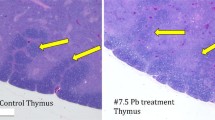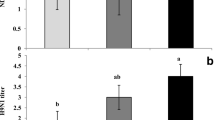Abstract
Forty-four pairs of game-farm mallards (Anas platyrhynchos) were fed ABATE® 4E (temephos) to yield 0, 1, or 10 ppm ABATE® beginning before the initiation of lay, and terminating when ducklings were 21 days of age. The mean interval between eggs laid was greater for hens fed 10 ppm ABATE® than for controls. Clutch size, fertility, hatchability, nest attentiveness of incubating hens, and avoidance behavior of ducklings were not significantly affected by ABATE® ingestion. The percentage survival of ducklings to 21 days of age was significantly lower in both treated groups than in controls, but brain acetylcholinesterase (AChE) activity was not inhibited in young which died before termination of the study. In 21-day-old ducklings, aspartate aminotransferase (AST) activity increased and plasma nonspecific cholinesterase (ChE) activity was inhibited by about 20% in both treatment groups, but there were no significant differences in brain AChE or plasma alanine aminotransferase (ALT) activities, or plasma uric acid concentration. Clinical chemistry values of adults were not affected. No ABATE®, ABATE® sulfoxide, or ABATE® sulfone residues were found in eggs or tissue samples.
Similar content being viewed by others
References
Barker, J. S.: Abate. ... a new mosquito larvicide. Proc. Chem. Spec. Manufact. Assoc.52, 160 (1966).
Barnett, J. B., J. M. Spyker-Cranmer, D. L. Avery, and A. M. Hoberman: Immunocompetence over the lifespan of mice exposedin utero to carbofuran or diazinon: 1. Changes in serum immunoglobulin concentrations. J. Environ. Pathol. Toxicol.4, 53 (1980).
Bowman, J. S., and E. J. Orloski: ABATE® insecticide residues in streams and ponds treated for control of mosquito larvae. Mosq. News26, 557 (1966).
Campbell, B. C., and R. F. Denno: The effect of temephos and chlorpyrifos on the aquatic insect community of a New Jersey salt marsh. Environ. Entomol.5, 477 (1976).
Carey, W. F.: Persistence of Abate in granule applications. Proc. 65th Ann. Mtg. NJ Mosq. Cont. Assoc., Cherry Hill, NJ. 85 (1978).
Dieter, M. P.: Plasma enzyme activities in Coturnix quail fed graded doses of DDE, polychlorinated biphenyl, malathion, and mercuric chloride. Toxicol. Appl. Pharmacol.27, 86 (1974).
—: Further studies on the use of enzyme profiles to monitor residue accumulation in wildlife: Plasma enzymes in starlings fed graded concentrations of morsodren, DDE, Aroclor 1254, and malathion. Arch. Environ. Contam. Toxicol.3, 142 (1975).
Ellman, G. L., K. D. Courtney, V. Andres, Jr., and R. M. Featherstone: A new and rapid colorimetric determination of acetylcholinesterase activity. Biochem. Pharmacol.7, 88 (1961).
Fleming, W. J., and S. P. Bradbury: Recovery of cholinesterase activity in mallard ducklings adminstered organophosphorus pesticides. J. Toxicol. Environ. Health8, 885 (1981).
Fowler, J. S. L.: Chlorinated hydrocarbon toxicity in the fowl and duck. J. Comp. Pathol.80, 465 (1970).
Franson, J. C.: Enzyme activities in plasma, liver, and kidney of black ducks and mallards. J. Wildl. Dis.18, 481 (1982).
Heinz, G.: Effects of methylmercury on approach and avoidance behavior of mallard ducklings. Bull. Environ. Contam. Toxicol.13, 554 (1975).
—: Methylmercury: Second-year feeding effects on mallard reproduction and duckling behavior. J. Wildl. Manage.40, 82 (1976).
Hill, E. F.: Toxicity of selected mosquito larvicides to some common avian species. J. Wildl. Manage.35, 757 (1971).
—, R. G. Heath, J. W. Spann, and J. D. Williams: Lethal dietary toxicities of environmental pollutants to birds. U.S. Fish and Wildlife Service Special Scientific Report-Wildlife No. 191. Washington, DC: USDI (1975).
Hollander, M., and D. A. Wolfe: Nonparametric statistical methods. New York: John Wiley & Sons (1973).
Kent, R., and D. J. Sutherland: The efficiency of the state airspray program-1977. Proc. 65th Ann. Mtg. NJ Mosq. Cont. Assoc. Cherry Hill, NJ, 199, (1978).
Kurtz, P. J., and M. H. Weeks: Effects of single and repeated exposures to ABATE on rat behavior and cholinesterase activity. Toxicol.13, 35 (1979).
Mulla, M. S., G. Majori, and A. A. Arata: Impact of biological and chemical mosquito control agents on nontarget biota in aquatic ecosystems. Residue Rev.71; 121 (1979).
Neter, J., and W. Wasserman: Applied linear statistical models. Homewood, IL: R. D. Irwin, Inc. (1974).
Ratcliffe, D. A.: Decrease in eggshell weight in certain birds of prey. Nature215, 208 (1967).
Rattner, B. A., L. Sileo, and C. G. Scanes: Hormonal responses and tolerance to cold of female quail following parathion ingestion. Pest. Biochem. Physiol.18, 132 (1982).
Sanders, H. O., D. F. Walsh, and R. S. Campbell: Abate: Effects of the organophosphate insecticide on bluegills and in-vertebrates in ponds. U.S. Fish and Wildlife Service Technical Paper No. 104. Washington, DC: USDI (1981).
Tucker, R. K., and M. A. Haegele: Comparative acute oral toxicity of pesticides to six species of birds. Toxicol. Appl. Pharmacol.20, 57 (1971).
Ward, D. V., and B. L. Howes: The effects of Abate, an organo-phosphorous insecticide, on marsh fiddler crab populations. Bull. Environ. Contam. Toxicol.12, 694 (1974).
—, and D. F. Ludwig: Interactive effects of predation pressure and insecticide (temephos) toxicity on populations of the marsh fiddler crabUca pugnax. Marine Biol.35, 119 (1976).
Winer, B.J: Statistical principles in experimental design. 2 ed. New York: McGraw-Hill (1971).
Author information
Authors and Affiliations
Rights and permissions
About this article
Cite this article
Franson, J.C., Spann, J.W., Heinz, G.H. et al. Effects of dietary ABATE® on reproductive success, duckling survival, behavior, and clinical pathology in game-farm mallards. Arch. Environ. Contam. Toxicol. 12, 529–534 (1983). https://doi.org/10.1007/BF01056548
Received:
Revised:
Issue Date:
DOI: https://doi.org/10.1007/BF01056548




